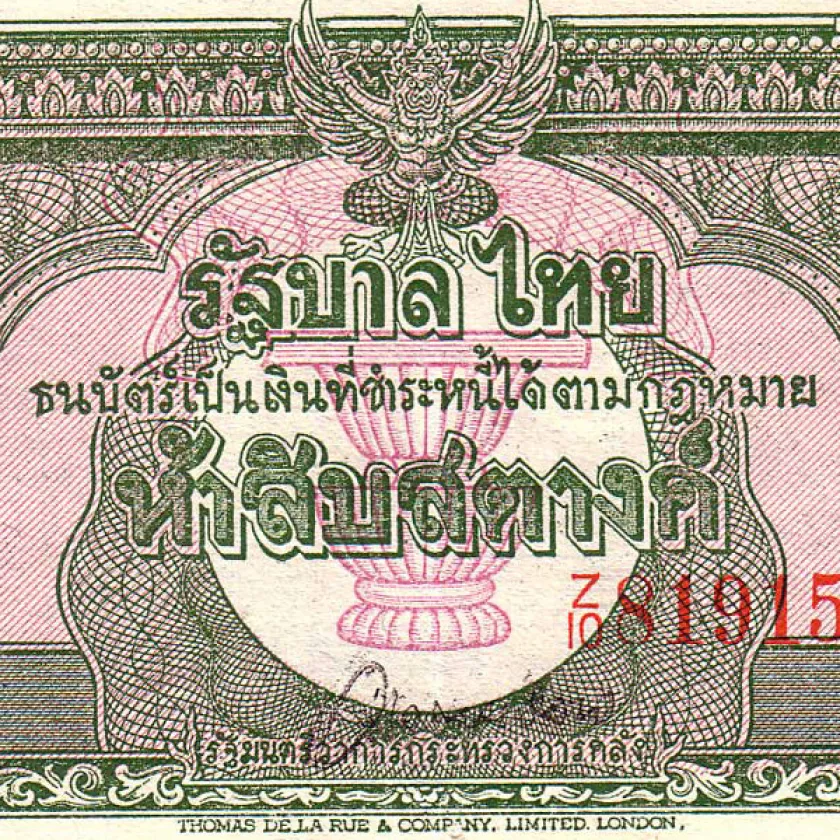Banknotes are not only legal tender for settling debts but also miniature historical records that reflect the political landscape, national ideologies, and economic development of the issuing country. Thus, we often find that banknotes from different countries feature images of political leaders or important national figures, along with symbolic designs that align with the nation's history and political direction. In Siam, banknotes were first introduced during the reign of King Rama V, featuring national emblems. This design continued until the reign of King Rama VII, when printing technology advanced enough to allow photographs to be included on banknotes. "Portraits of the King" (both current and past monarchs) began to appear as the main images, accompanied by the king's name and important national landmarks and events related to each king's reign. For example, the first series of banknotes issued during the reign of King Rama VII featured a portrait of King Prajadhipok on the front, along with images of the Grand Palace, the Suphannahong Royal Barge, and the Ping River landscape, symbolizing the nation's prosperity. The back of the banknote depicted Phra Samut Chedi, representing King Rama IV's benevolence in protecting the country during the crisis of 1893. This design approach has continued through to the current reign. However, during the period when the People's Party was in power, there was a series of banknotes that notably omitted the familiar royal portraits.
The 50 satang banknote produced during World War II and first issued around 1947 is the first and only series of banknotes in Thailand that did not feature the royal portrait (excluding the reigns of King Rama V and VI). Instead, it showcased a large Constitution Tray beneath the national emblem on the front, while the back depicted Phra Samut Chedi. This banknote clearly reflected the political ideology of the People's Party after the 1932 revolution, emphasizing the supremacy of democracy over the monarchy. However, this banknote had a regrettably short lifespan. Shortly after its introduction, the People's Party government was overthrown in a coup, and a new reign began. Consequently, the 50 satang banknote in this design was discontinued and replaced by banknotes that featured royal portraits in all denominations. Nonetheless, the attempt to communicate the democratic ideals through banknotes was evident in the previous series issued in 1938, which featured a portrait of King Rama VIII as the main image, overlaid with a watermark of the "Constitution Tray." The back of the banknote depicted the Ananta Samakhom Throne Hall, which had been converted into the parliamentary meeting place, symbolizing the transition from the throne of King Rama V to a democratic space for the people. This banknote can be seen as a compromise between the royalists and the People's Party, with the Constitution Tray and parliamentary meeting place representing the equality of the people alongside the royal portrait.
After the decline of the People's Party in 1947, and the resurgence of royalist power, symbols associated with democratic ideology rarely appeared on banknotes in subsequent reigns. Banknotes became tools for promoting royal nationalism. For example, the banknotes used in the current reign feature the portrait of the current King alongside portraits of previous monarchs: King Rama I and Rama II on the 20-baht note, King Rama III and Rama IV on the 50-baht note, King Rama V and Rama VI on the 100-baht note, King Rama VII and Rama VIII on the 500-baht note, and King Rama IX on the 1,000-baht note. These notes also include images of various royal activities from different reigns. None of these banknotes feature the image of the Constitution Tray, the symbol of the supreme law in the country's democratic system.

